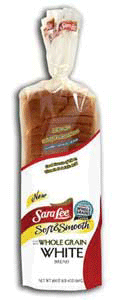 In my last post I kept referring back to that old simile of building the next great thing since sliced bread. Well, believe it or not there is innovation in things as common as sliced bread and Sara Lee is an example of a company who gets it when it comes to listening to consumers, identifying the real problems they are trying to solve, and then implementing a product that exceeds their expectations.
In my last post I kept referring back to that old simile of building the next great thing since sliced bread. Well, believe it or not there is innovation in things as common as sliced bread and Sara Lee is an example of a company who gets it when it comes to listening to consumers, identifying the real problems they are trying to solve, and then implementing a product that exceeds their expectations.
Sara Lee was one of 11 winners in the Chicago Innovation Awards in October and the success the award celebrated was their new Soft & Smooth Made with Whole Grain White Bread. If you click on the CIA link and select “2006 Awards” at the bottom of the page you will see a brief video of Peter Reiner, VP of Sara Lee brands, discussing how they came up with the truly innovative new bread by leveraging deep consumer insights.
What is it: a whole grain white wheat bread with the appearance, texture and taste of a refined white bread that young kids and adults love.
What problem it solves: Consumers in general realize they need to improve their diets and “whole grains” is one of the areas that the FDA and nutritionists have identified as a lack in many Americans’ diets. Heather Hawkes on the Harvard Medical School Consumer Health Information site explains,
New government guidelines recommend that Americans make half of their grains whole, eating three or more 1-ounce servings a day. Yet it’s estimated that the average consumer eats less than one-third of the recommended amount of whole grains and 40% of us never eat whole grains at all!
Moms want to feed their children healthy food and despair that their children refuse to eat wheat bread because it doesn’t taste good or is too “crusty” to eat. Kids want great tasting sandwiches made with white bread (that light and airy stuff with no nutritional value – think Wonder Bread when you were a kid). Just try to get a young child to eat wheat bread, experience shows they can be pretty intractable. One of the best insights I’ve seen came from a director of nutrition services in the Omaha Public Schools, “The hardest thing is to get a kid to eat something that’s brown or anything that looks like it has seeds in it.” Given the focus on children’s health and obesity, the Public Schools clearly have an interest here as well. In my house it’s not a problem, the girls eat nothing but Great Harvest whole wheat, but for most families this is a deep set issue.
But it’s not just about children either. As Heather Hawkes explains further in her article, research in the Harvard Medical School’s Nurses Health Study demonstrates that a diet with greater emphasis on whole grains also contributes to weight loss or maintenance for women.
Now if you know nothing else about food, you should quickly realize that children’s health and women’s weight are probably the two biggest lodestones when it comes to trends and issues in American eating. Find a product that reasonably and effectively answers these issues and you have just hit the mother lode.
So Sara Lee’s product captures both of these insights and satisfies both the target consumer and the target purchaser.
What are the results: The #1 selling bread in the bread aisle of your local grocer – a hotly contested shelf space. According to IRI data, Soft & Smooth sold 16.7 million 20 ounce loafs or $30.2 million in sales between the launch in July through December 2005. That’s $30 million in 6 months! Again, for those not in the know, a single new product launch into grocery that delivers $30 million in the first year is a homerun. Sara Lee knocked this one out of the park and on its way to the moon just on revenues. But other indicators show that this is not just a one hit wonder where consumers try it once and move on. A survey done by Sara Lee among the target audience showed that 90% of Women with Children in Household rated the bread in the top two boxes of Very Favorable or Somewhat Favorable and again 91% indicated a high intent to purchase again after first trial. The bread did so well for Sara Lee at launch that they cut ad spending and dedicated the marketing dollars to production in order to meet demand.
How did they do it: Sara Lee partnered with a K&A client, ConAgra Foods, (and by this I’m not implying we had anything to do with the product development) and is leveraging their Ultragrain Whole White Wheat as a key ingredient. What is White Wheat you ask? According to Ms. Hawkes, it is essentially albino wheat with none of the tannins and acids that make traditional wheat bread (made from red wheat flour) taste bitter:
Traditional wheat flour comes from red wheat. The bran layer contains tannins and phenolic acid, which are bitter and account for much of the taste difference between whole wheat and white bread. The red bran coloring is responsible in part for the darker color of whole wheat.
White wheat is a natural albino variety. It does not contain the tannins or acids that red wheat does, so the taste is sweeter and milder. The flour coloring is lighter, more golden. What’s more, it is touted as being the nutritional equivalent of its red wheat counterpart.
Sara Lee has leveraged this success into Whole Grain hamburger and hot dog buns and other breads that are equally experiencing strong success. So not only is this a great product, it also established a great platform for further product development in related spaces. There you have it, a great example of how focusing tightly on the problems customers face can lead to significant product success and strong customer loyalty. Sara Lee did go out and ask customers what they wanted, but they also went deeper and worked to identify the underlying issues and emotional drivers. This is the key to new product success in any business. Most marketers nod their head and say “Yup” when you say, “Thou shalt know thy customer.” Yet all they know is quantitative data which will tell you whether or not they like your product or brand, but it won’t tell you the kind of data that is gathered through ethnographic interactions and cultural research. You have to peel back the layers on the realities of your customers’ experiences. You have to REALLY know your customer, the world they inhabit and the true sources of the problems they face to see this kind of success. Either that or be extremely lucky.


